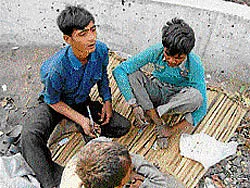Drug addicts on the street are now injecting pharmaceuticals like Avil, Smack, Forvent and Fenergan and other solvents instead of heroine or brown sugar.

This leads to a relapse of drug use after constant rehabilitation, say rights groups.
More than 90 per cent of the Injecting Drug Users (IDUs) are migrants from small towns, are homeless and residing on the streets.
Activists working towards the cause of rehabilitating IDUs say that drug addicts fall back time and again even after rehabilitation. “The main reasons behind the relapse is unemployment and lack of education which brings them back to the same situation as they were in before rehabilitation. Plus most of these drugs are easily available at local chemist shops, without a prescription.
The rehabilitation services are adequate but there is no ‘Bible’ for treatment,” said Rajiv Shaw, director projects with Sharan, a rights group. He works towards developing community based financial services for the urban poor. Rajiv was a drug addict in the 90s and believes that it has helped him bridge the gap between victims and the activists.
There are close to 40,000 IDUs spread across five main hot spots in Delhi — Meena Bazaar in Old Delhi, Hanuman Mandir near Connaught Place, New Delhi Railway station, Old Delhi railway station and Minto Road.
According to estimates, out of two lakh children living in slums and on the streets, nearly 30,000 children inject drugs due to several reasons such as poverty, peer pressure, experimentation, easy route to survival and forced sexual abuse.
“Children between the age group of 8 to 16 years are rampant users of drugs. They mainly inhale or smell solvents, whitener, thinner, ethyl, ether, cannabis, alcohol and heroin if they manage to purchase it from drug dealers,” said Poonam Sharma, communications coordinator with Salaam Baalak Trust.
She adds that it is extremely difficult to retain such children at their shelter homes as they feel caged and want to run away.
IDUs are subject to diseases like Tuberculosis, HIV, Hepatitis, and Abscess. These diseases are spread due to exchange and sharing of used needles to inject drugs.
“It is difficult to ask a IDU to abandon his habits at the first instance. So we provide around 1,900 new injections everyday at the hot spots to build a rapport with them and later counsel them to rehabilitate. We provide medical detoxification for 15 days to IDUs, informal education and medical assistance on a regular basis at our drop-out centres (rehabs),” added Shaw.
However, only 11 per cent of the IDUs seek health treatments in the city as most of them are locked in prisons. As an activist from Indian Harm Reduction Network, which helps to strengthen the quality of life of IDUs explains, “With high rates of HIV, HBV, and TB we are filling up the prisons with sick and exposed prisoners.”
